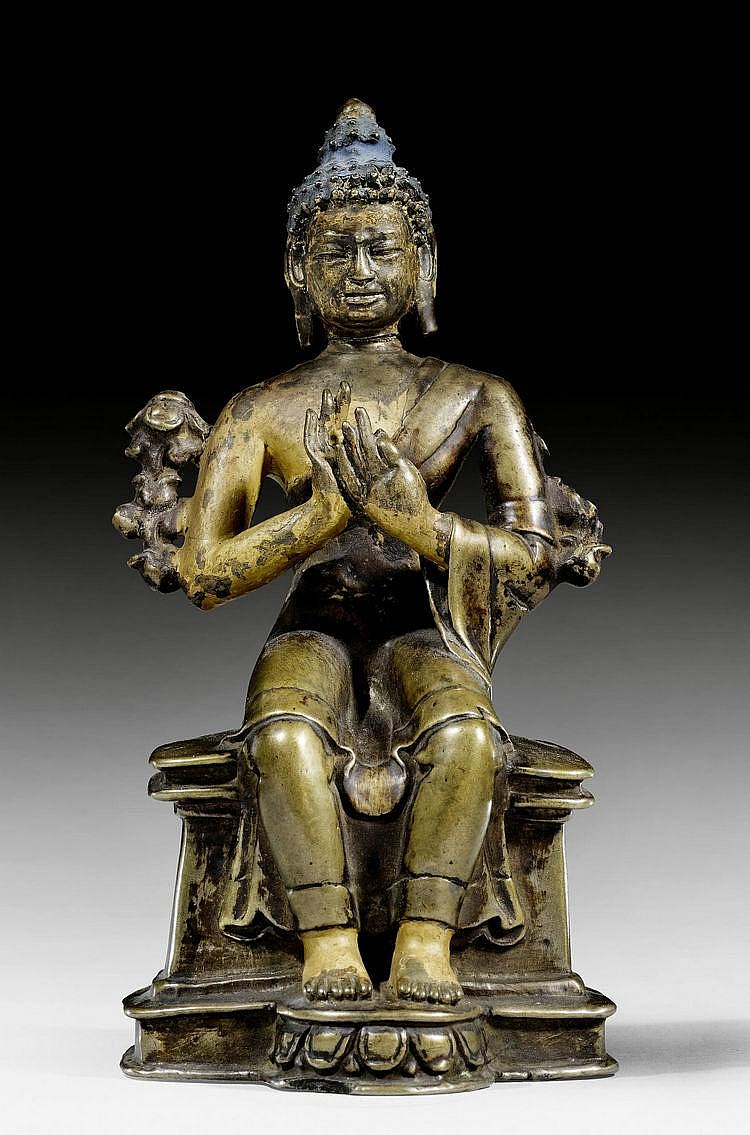Bodhisattva Maitreya Images
The Bodhisatta Metteya (Pāḷi) or Bodhisattva Maitreya (Sanskrit), in early doctrine was the first and only bodhisatta or bodhisattva. In the Buddhist tradition he is to appear on earth, achieve complete enlightenment as a future Buddha and teach the dharma according to scriptures. The Maitreya will be the successor of the historic Shakyamuni Buddha. The prophecy of the arrival of the the Maitreya is found in the canonical literature of all Buddhist traditions (Theravada, Mahayana, Vajrayana). Statues and figurines of this bodhisattva are relatively rare. The numbered images are part of the Apsarah Gallery Collection.
9th Century Bodhisattva Maitreya at Candi Mendut
Material: andesite stone, 3 metres high.
Colour: dark brown and highly polished after almost 1,200 years of being touched by human hands.
Posture: bhadrasana (seated on a throne). This is the usual asana for the seated Bodhisattva Maitreya.
Two arms with the hands showing the dharmacakramudra (the mudra of the rotation of the dharma wheel).
The clothing is barely visible, simple with no ornamentation and the head has a typical Javanese ushnisha.
This is the first Bodhisattva Maitreya I ever saw more than 35 years ago on my first visit to Central Java.
Note: It should be mentioned here that various web sites including Wikipedia, on their Mendut page, wrongly identify this statue as Dhyani Buddha Vairocana. Clearly from the asana and mudra, this image is indeed the Bodhisattva Maitreya
9th Century Javanese Bodhisattva Maitreya
 Material: bronze.
Material: bronze.
Patina: brownish-green
Posture: bhadrasana (seated on a throne). This is the usual asana for the seated Bodhisattva Maitreya.
Very similar to the Mendut statue with fine clothing and no ornamentation.
Two arms with the hands showing the dharmacakramudra (the mudra of the rotation of the dharma wheel) and an amsumala (nimbus) behind the head.
12th Century Tibetan Bodhisattva Maitreya
 Material: bronze.
Material: bronze.
Patina: light brown.
Posture: bhadrasana (seated on a chair). This is the usual asana for the seated Bodhisattva Maitreya.
Similar to the above in simplicity except for the lotus and taller more pointed ushnisha.
Two arms with the hands showing the dharmacakramudra (the mudra of the rotation of the dharma wheel).
1. Bodhisattva Maitreya
 Material: bronze.
Material: bronze.
Patina: dark brown.
Posture: bhadrasana (seated on a chair). This is the usual asana for the seated Bodhisattva Maitreya.
Four arms with the rear hands showing the vitarkamudra (teaching mudra) and the front hands showing the dharmacakramudra (the mudra of the rotation of the dharma wheel).
The figurine is tiny and appears to show perhaps 13th – 15th century Majapahit influence. The four arms with much ornamentation and a crown, would appear to indicate increasing tantric influences, compared with the larger early 9th century bronze from central Java and 12th century Tibetan Bronze.
2. Bodhisattva Maitreya
 Material: bronze.
Material: bronze.
Patina: dark brown.
Posture: bhadrasana (seated on a chair). This is the usual asana for the seated Bodhisattva Maitreya.
Four arms with the rear hands showing the vitarkamudra (teaching mudra) and the front hands showing the dharmacakramudra (the mudra of the rotation of the dharma wheel).
Very similar to the previous item.
The audio below is a mantra chanted in Sanskrit for the Bodhisattva Maitreya by Tibetan Lama Zopa Rinpoche.
